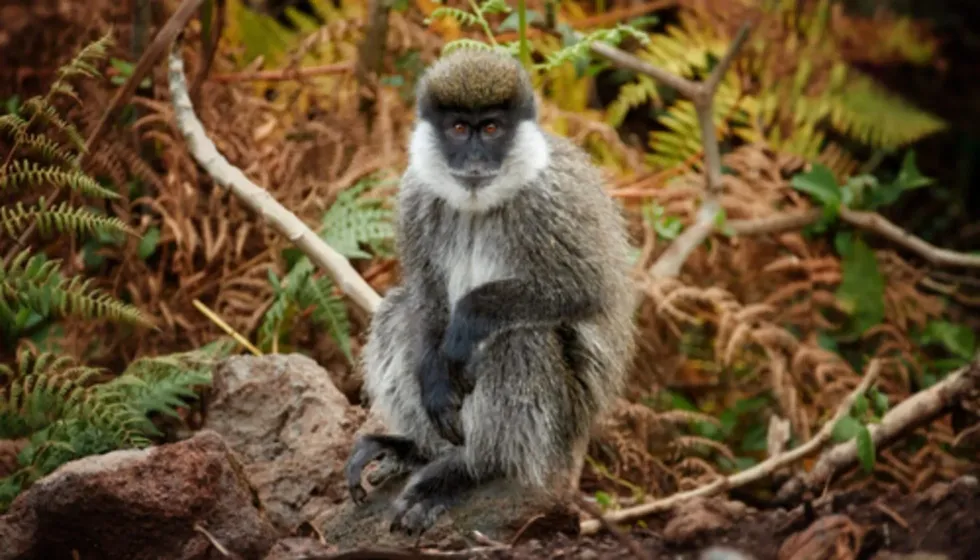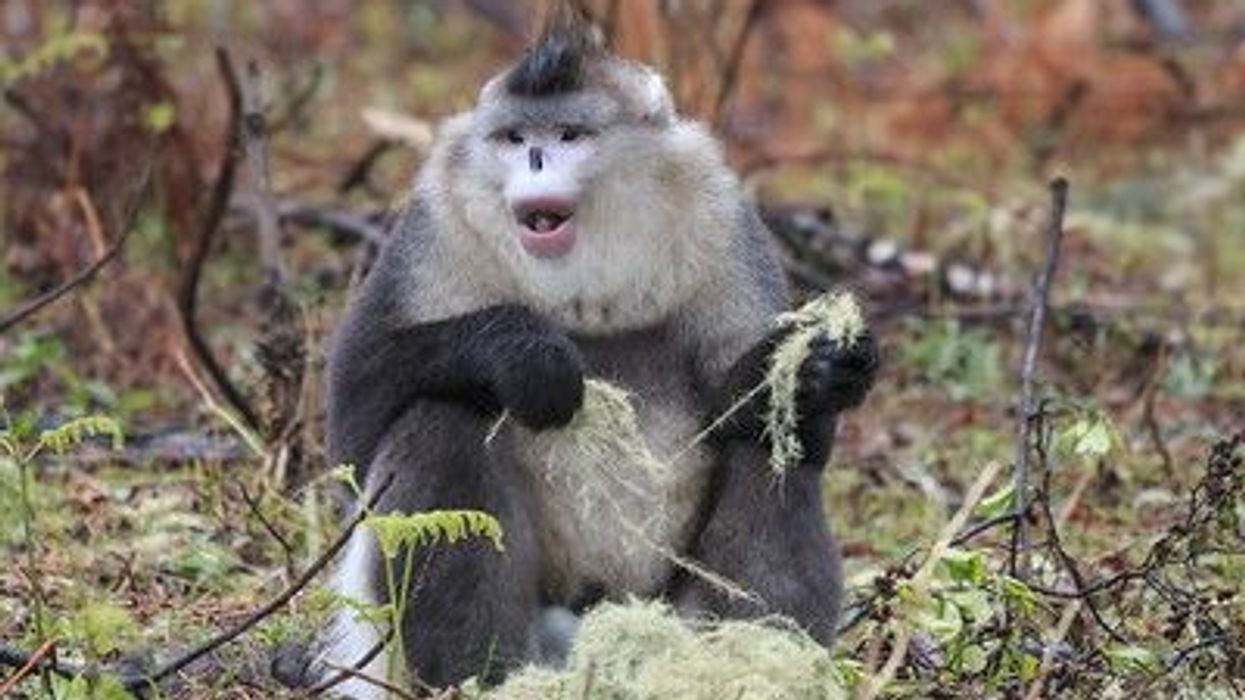The Bale Mountain vervet monkey (Chlorocebus djamdjamensis), commonly known as the Bale monkey, is a species of monkey that can be found only in one part of the world, in the mountain forests of the southern Ethiopian Highlands. The primary diet of this species mainly includes bamboos.
However, they have learned to adapt and feed on other species of plants as well over the years.
These African primates have small-shaped round heads and their bodies are covered with a dark brown colored coat of fur.
They belong to the genus Chlorocebus and the family of Cercopithecidae but were formerly part of the Cercopithecus genus. Considered to be a Vulnerable group of creatures according to the International Union for Conservation of Nature Red List, they owe this Vulnerable status to habitat loss and hunting.
Their behavior towards humans is rather shy and they tend to flee when encountered by one. This species breeds during the months of April and June and the gestation period for females usually lasts for five and a half months.
Following this, the female gives birth to a single offspring.
If you are fascinated by the Bale monkey, then you may want to continue reading our other amazing facts about them. If you want to learn more about different monkeys around the world, you can read up on Colobus monkey and spider monkey.
Bale Monkey Interesting Facts
What type of animal is a Bale monkey?
The Bale monkey is a species of monkey. Its scientific name is Chlorocebus djamdjamensis.
What class of animal does a Bale monkey belong to?
The Bale monkey (Chlorocebus djamdjamensis) belongs to the Mammalia class of animals and genus Chlorocebus. This species was formerly part of the genus Cercopithecus.
How many Bale monkeys are there in the world?
The population of Bale monkeys has been critically threatened by human intervention as well as habitat loss. As of now, the remaining population of this species is less than 10,000 individuals all over the world.
Where does a Bale monkey live?
The populations of Bale monkeys inhabit the forest regions of the Bale Mountains of Ethiopia. As a result of the living range of their populations, this species are called bale monkeys.
What is a Bale monkey's habitat?
This species of monkeys choose their habitat on the basis of the soil quality or climate of a particular region. Since a majority part of their diet consists of bamboo, they can be found in the bamboo forest regions in the Bale Mountains. Deeply forested regions or bushland do not fare well with this species of monkeys.
Who do Bale monkeys live with?
Like most other species of monkeys, Bale monkeys can also be found moving in packs or groups. The groups generally consist of one male dominant figure and other females that can range up 10 or more individuals. Monkeys, in general, are social creatures and are hardly seen moving alone.
How long does a Bale monkey live?
Found largely in the bamboo forests of Ethiopia, the lifespan of Bale monkeys can range from 11-13 years in the wild. Macaque monkeys can live for around 20-30 years in their range.
How do they reproduce?
The months of April and June are generally considered to be the breeding time for vervet monkeys. Females of this species reach sexual maturity at an early age of four years, whereas the males reach their sexual maturity at five years of age.
The gestation period for females lasts for five and a half months, following which the female gives birth to a single newborn young.
What is their conservation status?
Bale Mountains vervet monkeys are currently listed as a Vulnerable species by the International Union for Conservation of Nature Red List. There has been a rapid decline in their population over the years which has almost driven them to their extinction.
Habitat loss and hunting are the primary reasons behind the further decrease in the already threatened population of vervet monkeys.
Bale Monkey Fun Facts
What does a Bale monkey look like?
Found largely in the bamboo forests of Ethiopia, Bale monkeys are covered with a dark brown colored coat and have small-shaped round faces. The lower region or the abdomen of a male of this species is covered with blue skin.
One unique physical characteristic of Bale monkeys is that they possess cheek pouches that can be filled with food to consume later.
How cute are they?
Like other species of monkeys around the world, Bale monkeys with their large round eyes and round faces are considered by many to be cute. A baby Bale monkey especially is extremely cute and adorable to look at. However, they are known to be not very social with human beings.
How do they communicate?
Vervets, in particular, make extensive use of their vocalization capability to communicate with each other. Different calls may transmit different messages to others.
For example, a particular type of sound is emitted by this species to alert the others of an approaching threat, whereas a completely different type of sound is used by the others about potential prey. Members of the group behave accordingly to the sound that is being produced.
How big is a Bale monkey?
Although the exact size of Bale monkeys is not known, vervets in particular range from 17-19 in (43-48.2 cm) in length, where females are generally smaller in size than males. However, they are bigger in size than tamarin monkeys.
How fast can a Bale monkey jump?
Found largely in the bamboo forests of Ethiopia, Bale monkeys are largely ground-dwelling creatures. The exact speed of Bale monkeys is not yet known, however, vervets, in general, can move at a speed of 30 mph (48.2 kph).
How much does a Bale monkey weigh?
Bale Mountains vervet monkeys generally weigh between 9-12 lb (4-5.4 kg). Females are smaller in size than males. Langur monkeys are much heavier than them.
What are the male and female names of the species?
There is no sex-specific name for this species of monkeys. Males are called male Bale monkeys, and females are known as female Bale monkeys.
What would you call a baby Bale monkey?
A baby Bale monkey goes by the name of an infant.
What do they eat?
The Bale Mountains vervet largely feeds on bamboo, typically on the African alpine bamboo. However, depending on the habitat region, from continuous forests to fragmented forests, their diet has changed a lot over the years.
Those residing in fragmented forests do not fixate on bamboo to be their only source of food and can be seen consuming other species of plants as well. They are also known to sometimes feed on crops.
How active are they?
Found largely in the bamboo forests of Ethiopia, these African primates are socially active creatures. They form a large group that is typically male-dominated and also converse with each other through a variety of calls. However, they are known to display extremely shy behavior around human beings and maintain as much distance as possible from them.
Would they make a good pet?
No, the Bale Mountains vervet monkey does not at all make a good pet. As it is, their population is gradually decreasing and they do not do well around human beings.
They are rather shy and will immediately flee when encountered by a human being. The best way to take care of them is by granting them freedom in the wild.
Did you know...
Bale Mountain vervets is endemic to the Bale Mountains of Ethiopia.
Bale monkeys were formerly considered to be a subspecies of the grivet species (Chlorocebus aethiops). They are considered to be the least known primates of Africa as they were only discovered in 1902.
Hybridization between the grivets (Chlorocebus aethiops) and the vervets (Chlorocebus pygerythrus) is among the many reasons for the decline in populations of this species.
Can monkeys eat bamboo?
Yes, monkeys can eat bamboos. In fact, bamboos make up 70% of the diet for the species of golden monkeys. Other than golden monkeys, the Bale Mountains vervet found largely in the bamboo forests of Ethiopia is also one such species that relies heavily on young bamboo leaves for their daily source of food.
How many babies do Bale monkeys have?
Vervets, in general, give birth to a single offspring. The sexual maturity differs from male to female, where females reach theirs at four years of age, whereas males reach theirs at five years.
Here at Kidadl, we have carefully created lots of interesting family-friendly animal facts for everyone to discover! For more relatable content, check out these woolly monkey facts and howler monkey facts for kids.
You can even occupy yourself at home by coloring in one of our free printable blue monkey coloring pages.










